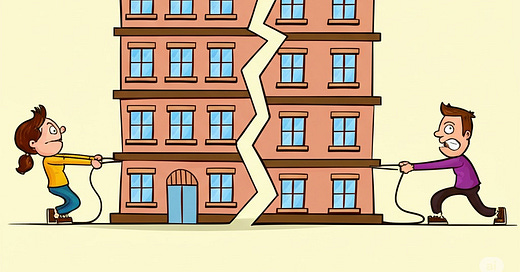The Bill Breaking California's Housing Organizations
A Housing Movement Divided Against Itself Cannot Stand
California’s housing movement is at war with itself.
The state has failed to build enough homes for decades. Rents remain sky-high. But organizations focused on solving the problem disagree on how.
The clash centers on SB 79, a bold new housing law proposed by State Senator Scott Wiener. YIMBYs (“Yes In My BackYard” pro-housing advocates) support the bill, trumpeting it as a breakthrough for future development. Some low-income housing advocates push back, warning the bill could undermine housing equity and affordability.
These factions form the core of the state’s pro-housing coalition. Why are they divided?

The Bill
If passed, SB 79 would automatically change zoning rules to allow denser housing near train stations and high frequency bus lines, 6-7 stories within a quarter mile of transit and 4-5 stories within a half mile.1 Essentially, it sweeps away local barriers to housing in the areas its supporters believe make the most sense to build.
The bill comes with no strings attached: No expensive labor requirements, no built-in “inclusionary zoning” requirements (local rules requiring a portion of new housing be set aside for low-income residents), no special fees.2 To address concerns about new development forcing existing residents out of their homes, SB 79 does not apply to sites with rental housing that has been occupied by tenants within the last ten years. Otherwise, it can be used almost anywhere within a half mile of major transit stops.
SB 79 could mark a major shift in California housing policy. The state has passed dozens of laws in recent years attempting to spur new development. Those efforts have mostly failed, in large part because the legal changes tack on too many costly requirements to make housing financially feasible. SB 79 represents efforts by YIMBY organizations to break the logjam by doing away with the strings.
However, SB 79 faces strong headwinds in the California Senate. It nearly died twice in California’s Senate, passing out of committees by just one vote over the heads of powerful party leaders. One Democrat, chair of the Senate’s influential Housing Committee, called the bill a “sweetheart deal” for developers that won’t help “regular California.” It still faces a final committee and then a full vote on the Senate floor before going to the more housing-friendly State Assembly.
Given the opposition, passing SB 79 may well require a united housing movement. Thus far, the different factions of California’s housing advocacy community have been as divided as ever.
The Controversy
Organizations representing subsidized low-income housing developers wrote a “letter of concern” detailing issues they see with the bill. They argue that:
Because SB 79 does not have an “inclusionary” requirement mandating low-income housing written into the bill, it will primarily produce high-end market-rate housing. They argue that housing will not serve the lowest-income residents who most need help.
SB 79 weakens the incentive created by existing state laws for for-profit developers to provide low-income housing for free. Current state laws allow developers to get increased density and faster environmental review, making their projects more profitable, in exchange for giving away a portion of their projects to low-income residents—which is very expensive. They’re essentially arguing state bills that make housing easier to build should come with more strings attached.3
An outright opposition letter sent by a handful of legal advocacy groups repeats many of the same arguments and adds some new ones. Most strongly, they write
Fair housing is not just about what gets built but about who can choose where to live and what one’s community looks like. By removing the processes that require community input, SB 79 leaves low-income communities and communities of color without notice, without a seat at the table, and without the tools to address the health, environmental, and fair housing consequences of major land use changes.
Fundamentally, the legal advocacy organizations argue that building housing equitably requires input from local communities. They oppose efforts at state-level zoning changes that remove opportunities for public input on private development.
A historical tangent, these critiques are a fascinating rehash of debates in 2018 and 2019, when YIMBY organizations ran similar bills supporting upzoning near transit. Back then, low-income housing advocates helped kill the legislation in committee. Now, though, SB 79 has narrowly survived two committees, a sign of changing state politics.
Shared Goals, Different Approaches
I work professionally with both low-income housing advocacy organizations and YIMBYs. In my experience, both factions earnestly want to support equitable development and low-income tenants. They just have different approaches based on different philosophies of how housing works, why it is expensive and what to do about it.
Some differences: Low-income housing advocates argue equitable development requires community input centering low-income tenants at city meetings; YIMBYs argue “community input” processes favor whiter, wealthier, and older residents who are more likely to be homeowners, not renters of color. Low-income housing advocates support high “inclusionary zoning” standards mandating low-income housing in all projects; YIMBYs argue unreasonably high standards make development infeasible. Low-income housing advocates argue new housing displaces existing residents; YIMBYs argue new housing reduces rents and limits displacement.
These intellectual disagreements have all bled into the SB 79 dispute.
The organizations also have different scopes of focus. Many of the low-income housing advocacy groups zero in on the hyper-local community level, organizing on a city-by-city basis. Low-income housing developers see the immediate challenges their own projects face with funding and political opposition, problems most of them are more immediately focused on solving that can’t be fixed by sweeping zoning changes. Some tenant organizing groups blame new housing for gentrification.4 They listen to the problems local residents face and strive to address them directly—such as with the “inclusionary zoning” mandates that theoretically require all new housing comes with some low-income options.
YIMBYs often organize locally as well, but they tend to take a more regional or even national outlook. As YIMBY writer
wrote in a piece supporting SB 79,, “Democrats both at the state and federal level are looking at the grim projections of California’s housing shortage ceding more population to red states, who are rapidly out-building California in homes.” The state politics may have shifted toward YIMBY ideas about housing in part because of the brutal reality of such a gloomy electoral future.In the YIMBY view, Texas and Florida have outcompeted California for residents—and therefore electoral college votes—because they build a lot of housing, providing more affordable living options in the process. Throughout the 2020s, those states regularly built 2-3 times the amount of housing California did. YIMBYs see California’s underproduction of housing in high-cost areas to be an existential political threat as well as a humanitarian catastrophe.
The Future of the Housing Movement
Full disclosure, the organization I work for professionally—the Housing Leadership Council of San Mateo County, a low-income housing advocacy group—has endorsed SB 79. (Though this piece is 100% my own opinion and does not reflect my employer.)
Our state faces an existential political crisis, the culmination of decades of self-induced housing shortage. We build dramatically less housing than other states. Heck, we build dramatically less housing than we did 50 years ago, when the state was more affordable.
California’s low-development status quo is already inequitable, already forcing people to leave their homes. “Inclusionary zoning” and community input can, counterintuitively, cause even greater displacement if they render new housing financially infeasible to build. Mandating 20% (or some other arbitrarily high percentage) of low-income housing in all new development doesn’t get us very many new low-income units if zero new units get built overall.
Recognizing the broken status quo, SB 79 was not controversial among HLC’s membership, even though our policy committee and board consists of low-income housing developers, tenants rights lawyers, local jurisdiction staff, and union representatives.
We built consensus in part by framing SB 79 as part of a broader effort to promote housing affordability rather than a standalone bill. SB 79’s biggest proponents in the legislature are working to pass public funding that will subsidize low-income housing production, a deal sweetener for the low-income development community. Legislators are also moving a package of streamlining laws, many of which would speed up low-income housing production. Contextualizing SB 79 helped bring people along.
The Housing Leadership Council’s board is a microcosm of a powerful statewide coalition, a coalition that could be virtually unstoppable if it moved in lockstep. As SB 79—and other important legislation—moves forward, let’s hope the housing community can unite around shared values to support the homes we need.
For the basics of zoning, read my pop history at https://open.substack.com/pub/jeremyl/p/zoning-controls-your-life-and-it?r=74nn5&utm_medium=ios
The bill still allows local inclusionary zoning ordinances to apply if a city has one, there just isn't any requirement written into the bill itself. To learn more about the costs of building housing in California, you can read a recent report by the RAND Institute, a think tank.
Some groups, including the organization I work for, also expressed concerns about changes the bill made to California rules incentivizing subsidized low-income housing development on publicly owned land. The bill has since been amended to address those concerns so I’m not covering them here.
Darrell also has a good piece on gentrification.





20% x 0 = ZERO. What’s the point of these “inclusionary” housing requirements if nothing gets built?
The whole premise here that "communities" exist and have rights is fallacious.